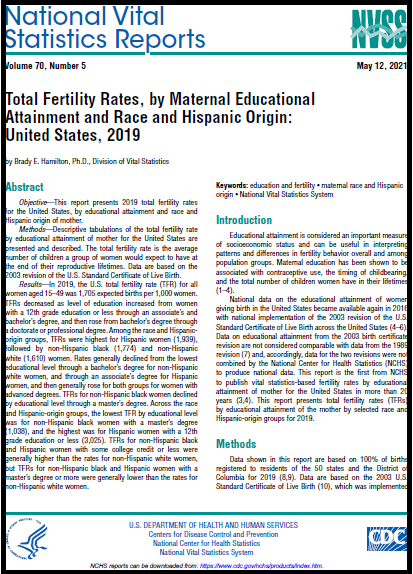Total Fertility Rates, by Maternal Educational Attainment and Race and Hispanic Origin: United States, 2019
Posted on by Questions for Brady Hamilton, Health Statistician and Lead Author of “Total Fertility Rates, by Maternal Educational Attainment and Race and Hispanic Origin: United States, 2019.”
Questions for Brady Hamilton, Health Statistician and Lead Author of “Total Fertility Rates, by Maternal Educational Attainment and Race and Hispanic Origin: United States, 2019.”
Q: What is the difference between general fertility rates and total fertility rates?
BH: The general fertility rate is the number of births per 1,000 females aged 15–44 in a given year, whereas, the total fertility rate is the estimated number of births that a group of 1,000 women would have over their lifetimes, based on age-specific birth rates in a given year.
Q: Why did you decide to compare educational attainment with total fertility rates?
BH: Educational attainment is considered an important measure of socioeconomic status and can be useful in interpreting patterns and differences in fertility behavior both overall and among population groups. Maternal education has been shown to be associated with contraceptive use, the timing of childbearing, and the total number of children women have in their lifetimes. I wanted to examine the association between educational attainment and the expected number of births for women using the latest available vital statistics birth data (2019) from NCHS.
Q: How did the total fertility rates differ by educational attainment?
BH: Total fertility rates decreased as level of education increased from women with a 12th grade education or less through an associate’s and bachelor’s degree, and then increased from bachelor’s degree through a doctorate or professional degree, although the increase from master’s to doctorate or professional degree was not statistically significant.
Q: How did the total fertility rates by educational attainment differ by race?
BH: The patterns in and levels of the total fertility rates by educational attainment differed across the three race and Hispanic-origin groups shown in the report.
Total fertility rates generally declined from the lowest educational level through a bachelor’s degree for non-Hispanic white women, and through an associate’s degree for Hispanic women, and then generally rose for both groups for women with advanced degrees. Rates for non-Hispanic black women declined by educational level through a master’s degree.
Total fertility rates for non-Hispanic black and Hispanic women with some college credit or less were generally higher than the rates for non-Hispanic white women, but TFRs for non-Hispanic black and Hispanic women with a master’s degree or more were generally lower than the rates for non-Hispanic white women
Q: Was there a specific finding in the data that surprised you from this report?
BH: Yes, the span of the range in the total fertility rates was surprising, from the low of 1,284 for women with a bachelor’s degree to the high of 2,791 for women with a 12th grade education or less. To put this difference in perspective, a woman with a 12th grade education or less would be expected to have more than one additional birth compared with a woman with a bachelor’s degree.
Posted on by

